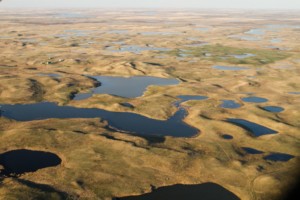A huge array of longstanding and crucial programs at the Environmental Protection Agency could face drastic cuts or complete elimination, according to a draft 2018 budget sent out by the Trump administration last week.
The 23-page 2018 budget proposal sent by the White House Office of Management and Budget (OMB), was obtained by the Associated Press last week. The proposal reduces the EPA’s overall budget by 25 percent to $6.1 billion and cuts staffing by about 3,000 jobs. Major programs on the chopping block include climate protection, environmental justice and enforcement, and toxic sites cleanup nationwide.
According to the Associated Press, the document states “The administration’s 2018 budget blueprint will prioritize rebuilding the military and making critical investments in the nation’s security. It will also identify the savings and efficiencies needed to keep the nation on a responsible fiscal path.”
Historical EPA spending
At present, the EPA only accounts for about 0.2 percent of the annual federal budget. As the chart below shows, though dollar spending on the EPA has increased since 1971, when adjusted for inflation, today’s spending is about the same it was back in 1981. In addition, the EPA’s percentage of the federal budget is at its lowest since the agency began in the early 1970s.
The document, known as a “passback,” is meant to be a first draft of the budget that will eventually be sent to congress. While the agency has opportunity to send feedback and suggestions, the initial items marked for cuts or elimination are an indicator of the Trump administration’s view of the EPA’s role, which many Republicans have previously called a “job-killer.”
According to the document, items marked for cuts or elimination include many designed to improve water and air quality, and a great number of recent regulations aimed at reducing greenhouse gas emissions – including the Clean Power Plan, a major initiative by former President Obama to reduce carbon emissions from each state.
In addition to overall budget and staffing cuts, the draft proposal for the EPA would also cut the climate protection budget by nearly 70 percent to $29 million, the Great Lakes Restoration Initiative by 97 percent to $10 million and environmental justice programs by 79 percent to $1.5 million.
Also targeted for steep spending rollbacks are the agency’s monitoring and enforcement of compliance with environmental laws, as well as regional projects intended to benefit degraded areas such as the Chesapeake Bay, Puget Sound and the Gulf of Mexico. A program dealing with San Francisco Bay that received $4.8 million last year would be eliminated, as would initiatives for reducing diesel emissions and beach water quality testing.

According to a draft budget sent by the OMB, EPA funds set for the clean up and restoration of waters in the San Francisco Bay will be eliminated.
The Washington Post, who also reported on the document, states 38 separate programs would be eliminated entirely. State grants to clean up toxic pollution at brownfield industrial sites would be cut by 42 percent to $14.7 million. It would also reduce funding for enforcing pollution laws by 11 percent to $153 million.
Major programs vulnerable to cuts in proposed 2018 EPA budget:


![The proposed budget would reduce EPA's funding for enforcement and compliance to federal regulation by about $129 million. Enforcement and compliance [-31%]](https://america.cgtn.com/wp-content/uploads/cache/2017/03/industrial_enforcement/2913237026.jpeg)
![The proposed budget would refocus development funds to core air and water related tasks and shift away from grants related to efficiency and emissions technology. Research and development [-49%]](https://america.cgtn.com/wp-content/uploads/cache/2017/03/Nellis_AFB_Solar_panels/453173336.jpg)
![Energy Star is a voluntary program that sets efficiency and environmental standards for consumer and industrial goods. The budget would eliminate Energy Star and more than 50 other programs. Energy Star and other efficiency programs [ELIMINATED]](https://america.cgtn.com/wp-content/uploads/cache/2017/03/1200px-Energy_Star_logo/3788244317.jpg)


![Since 2008, the EPA has been issuing state grants to speed up transition from high emission diesel engines to more efficient and cleaner burning vehicles. Diesel soot is cancer-causing and a major air pollution source. Diesel emissions [ELIMINATED]](https://america.cgtn.com/wp-content/uploads/cache/2017/03/truck2/2418586782.jpg)
Leaked details of the draft budget have caused a great deal of uncertainty and nervousness by employees of the EPA. In a March 2 memo acquired by CGTN America, OARM Acting Assistant Administrator Donna Vizian urged workers to stay focused and stated “we will do everything in our power to protect our ability to support the mission of the agency in protecting human health and the environment.”
“I have been assured [EPA] Administrator Pruitt will be working hard on our behalf to represent us in budget negotiations. That does not mean changes will not happen, but it does mean he wants to take a pragmatic approach,” Vizian also stated in the memo.
The Clean Water Rule
For many areas of environmental regulation, Trump does not need to go through a formal budget process. On February 28, he signed an executive order that would roll back 2015’s Clean Water Rule, which was an expansion of the Clean Water Act of 1972. The rule was designed to expand the federal government’s ability to regulate pollution in 60 percent of U.S. bodies of water, including the wetlands, smaller streams and rivers that flow into larger bodies of water like the Chesapeake Bay. Due to multiple suits, mostly from the farm lobby, the rule was never fully enacted.
Before being tapped by Trump to head the EPA, as Oklahoma’s attorney general Pruitt sued the agency at least a half-dozen times. He also led a multi-state lawsuit against the Clean Water Rule, calling it “the greatest blow to private property rights the modern era has seen.”
Other climate programs
The Washington Post also reported a four-page memo sent from OMB to the National Oceanic and Atmospheric Administration. The scientific agency, which is part of the Commerce Department, studies changes in climate, weather, oceans and coasts. The OMB outline proposed drastic cuts in specific areas, such as education, grants and research. NOAA’s Office of Oceanic and Atmospheric Research is slated to lose 26 percent, or $126 million of funds allotted in the current budget.
Moving forward
While the Trump administration looks to limit the scope of the EPA’s powers, there are some Republicans in congress that wish to eliminate it entirely. In February, Rep. Matt Gaetz of Florida introduced H.R. 861, a measure that would “terminate” the EPA by 2018.
In an interview with environmental website E&E, new EPA administrator Scott Pruitt stated he would speak to the White House about preserving some of his agency’s budget. Specifically state grants having to do with water and air safety.
In a statement March 3, Gina McCarthy, EPA Administrator under Obama said, “This budget is a fantasy if the administration believes it will preserve EPA’s mission to protect public health. It shows the Trump administration doesn’t hold the same American values for clean air, clean water and healthy land as the vast majority of its citizens.”
Following a period where the passback budget will reviewed, negotiated and revised by both the administration and the individual agencies, the Trump administration states it will to unveil its 2018 federal budget the week of March 13.
Budget numbers from OMB “passback” originally reported by The Associated Press, Reuters, and The Washington Post.
 CGTN America
CGTN America





